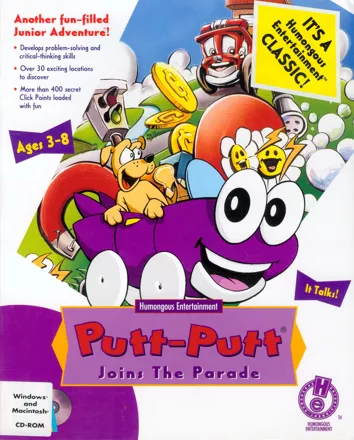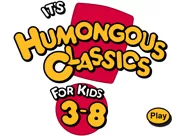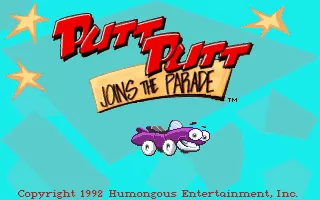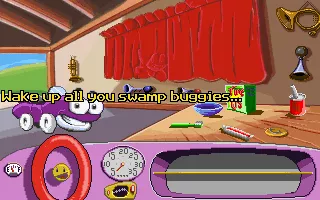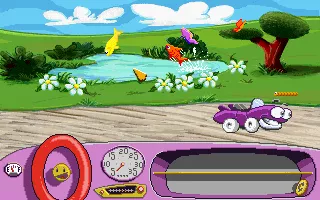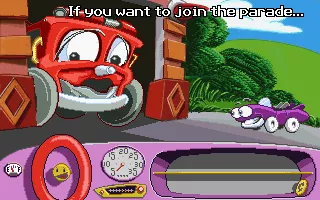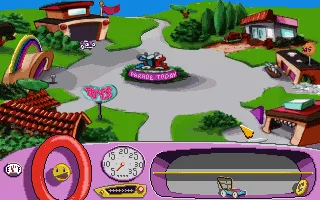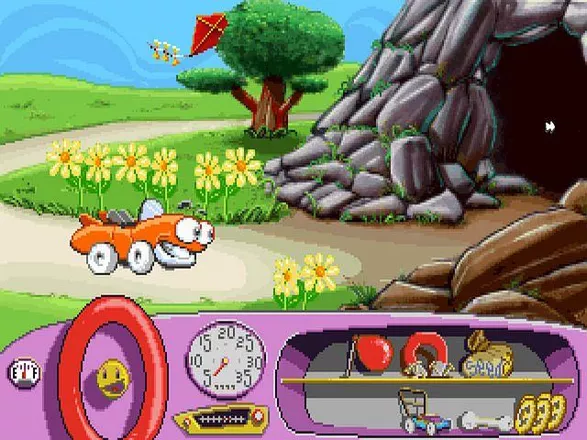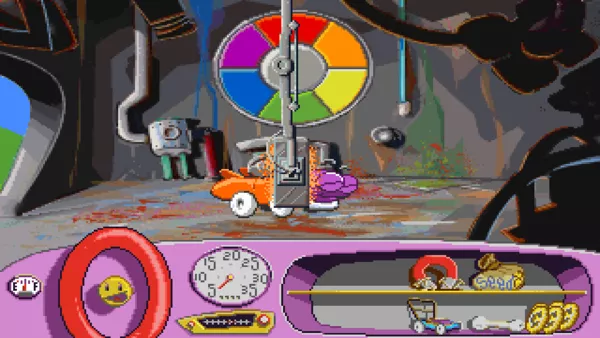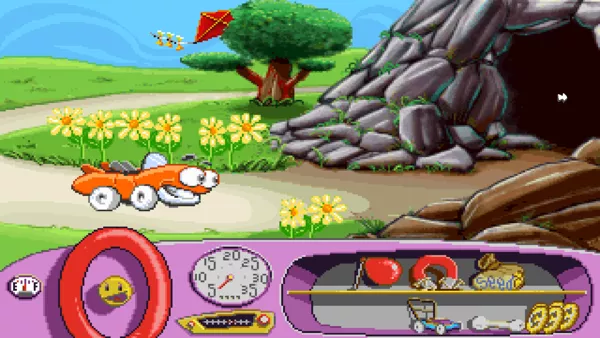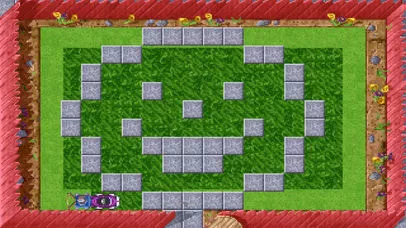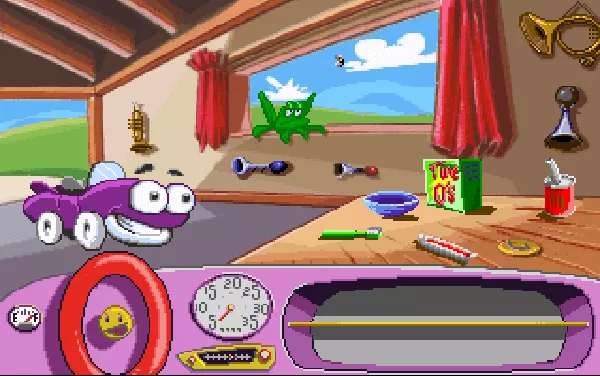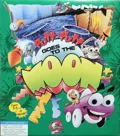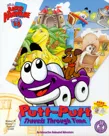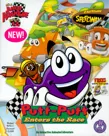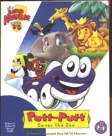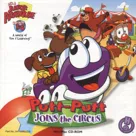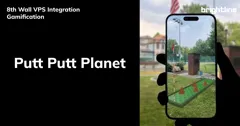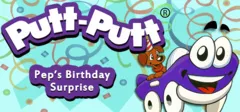Putt-Putt Joins the Parade
Description official descriptions
Putt-Putt, an adorable purple car, wants to join the Cartown Parade. But, first, he must earn money for a carwash, find a balloon, and get a pet (Pep, the puppy). Children ages 3 to 8 have a great time delivering groceries and mowing lawns and learn good lessons like waiting for the green light before crossing the road. Each screen has a multitude of fun things to click on, as well.
Spellings
- Автомобильчик Бип-Бип на Праздничном Параде - Russian spelling
- パットパットとパレードに行こう - Japanese spelling
Groups +
Screenshots
Promos
Videos
Add Trailer or Gameplay Video +1 point
See any errors or missing info for this game?
You can submit a correction, contribute trivia, add to a game group, add a related site or alternate title.
Credits (DOS version)
20 People · View all
| Project Leader | |
| Design | |
| Writing / Dialogue / Story | |
| Programming | |
| Graphics / Artwork | |
| Additional Graphics / Artwork | |
| Animation | |
| Interpreter / Development System | |
| Music | |
| Audio Engineer | |
| Audio Director | |
| Lead Tester | |
| Additional Testing by | |
| [ full credits ] | |
Reviews
Critics
Average score: 80% (based on 11 ratings)
Players
Average score: 3.7 out of 5 (based on 41 ratings with 3 reviews)
A great game for kids (and parents too!)
The Good
This was the first computer game our son ever played - at 2 1/2 he would sit on Daddy's lap and point to where he wanted to go. By three he was operating the mouse himself! While older children may enjoy the challenge of solving the game, this game is great for the youngest child, too, because it has lots of fun little things to click on in every screen. And, the animation, voice acting and music are truly delightful - unlike some kids' games, the music doesn't get on your nerves after 5 minutes.
The Bad
I honestly can't think of anything bad to say about it.
The Bottom Line
This is a great game for young children, probably the best Putt-Putt game to start with since it is the simplest and everything stays the same from one play to the next (unlike later games such as Enters the Race and Travels through Time.) A lot of fun for parents and children to play together!
DOS · by Melissa Leonard (100) · 2000
A simple story, but lots and lots of detail!
The Good
The game is quite simple - both in terms of being easy (OK for its intended age group, usually of course too easy for adult children) to solve and not having any complicated storyline. The graphics are nice and cute, but it's not what I like most about the game...
A thing I can't emphasize enough are those little touches and details, which are extremely abundant in Putt Putt games. The games have a simple story, but it's also possible to visit some places which aren't necessary for completing the game and pretty much the whole environment is interactive. A tree? A flower? A shop crate? - it's always very likely that this particular element can be clicked for a funny little animation. Flowers spin, dance or drink water, mushrooms jump on top of one another, vegetables at the grocery spit seeds, a chest in front of somebody's garage opens and lets out a whole fruit parade...
There are always some small differences between each game - such as the addresses to which Putt Putt delivers groceries - but what prevents this game from getting boring despite it's very low difficulty level and foreseeable storyline are first of all those little touches.
The Bad
Just to note: out of some mysterious reason I dislike "talkie" games - however, Putt Putt games are an exception. But this very aspect could have been done better. The speech is sometimes a bit unclear for non-native English speakers - especially in one of the fragments not required to complete the game: the scene with joking animals at the toy store. It's a pity because it's the speech which makes this game even more educational for children from non-English speaking countries. Is "Putt Putt Joins the Parade" truly educational? It doesn't really teach much, I would rather call it an adventure game with a difficulty level suitable for quite small kids. However, pretty much any game with much spoken or written text - so any adventure game - really can do much to expand the player's proficiency in a foreign language. I have noticed it in my own case at the age of 13.
The Bottom Line
Most of what I have written also applies to later Putt Putt games. The graphical style changes later - becomes more cartoony, even more colorful and sometimes just too sweet. In each game you have to do different things, but the gameplay is similar - completing a few small tasks (no complicated strings of events like in adventure games for older children and adults) to reach a final goal. And, fortunately, another thing that remains are those small details. The games won't get boring too soon because it's always curious to look for those details - isn't this bush or that star animated too?...
DOS · by Nowhere Girl (8782) · 2012
The unassuming debut of a great company
The Good
Released all the way back in 1992, this is the first of many games made by Humongous Entertainment, and the first of the Junior Adventures. Though often referred to as edutainment games, it's debatable whether or not they can even be considered a part of this genre. Whereas most conventional edutainment games consist primarily of educational exercises with a child-friendly presentation, the Junior Adventures are full-fledged point-and-click adventure games that simply happen to be aimed primarily at children. These games exist first and foremost to entertain, with most of their educational value simply being a side-effect of their puzzles. Not that that's a bad thing. It really makes them stick out among their peers and gives them far more cross-generational appeal.
Mechanically, this game, much like its followups, has much in common with LucasArts adventure games (which is hardly surprising, considering the company was formed by LucasArts veterans), albeit with some alterations for increased child-friendliness. Such as the absence of verbs. Everything can be interacted with simply by either clicking on it or dragging an item onto it. The game is also fully voiced, which was still somewhat of a rarity at the time.
You can also see what would later become the core philosophy of most of the Junior Adventures take shape here. It's a fairly non-linear game in which you quickly gain access to most of its world. Early on, you are given an overview of the primary objectives you need to fulfill, which can then be tackled in any order, as their puzzle chains are largely independent of one another. In addition to gameplay-relevant interactables, there are also numerous so-called clickpoints which can play a variety of small animations. These mainly exist to entertain the youngest players, but I still find them interesting to observe even as an adult, as they help give these games more personality and serve as an excellent showcase of the company's creativity. This comes more into play in later games, though. The clickpoints here are less frequent and mostly just cute or mildly humorous, with most of the wackiness of the clickpoints in later games still absent. What does make them stick out a little however is that there are a few that temporarily change the game's music, something that Humongous would never experiment with again.
The Bad
You may have noticed that the section above revolves almost exclusively around the general formula of the Junior Adventures, rather than this game specifically. And the reason for that is that while this game may have established much of said formula, it doesn't execute it nearly as well as most of its successors. Though the game has some legitimate effort put into it, you can its developers were still in the process of finding their style and experimenting with what does and doesn't work, in addition to being held back by a low budget and the technical limitations of the time.
For starters, the graphics have aged very poorly. They look very crude and lacking in detail compared to the mostly hand-drawn graphics of later games. They do allow for Putt-Putt to move freely around individual screens (contrary to the hand-drawn games, where the player characters almost always stay in the same spot on each screen), but there are no puzzles that take advantage of this. All it does it make navigation needlessly slow, especially due to Putt-Putt's slow movement speed.
The music also leaves much to be desired. It has a poor sense of rhythm, often almost sounding more like a collection of sounds than actual music. And it doesn't have much personality either, instead simply conveying a generic lighthearted atmosphere. How exactly the music sounds depends on the version of the game. The DOS and Mac versions make use of a MIDI-style format, whereas the Windows version uses a digital recording of the same music. It's not a bad rendition, but it does suffer from heavy compression. The 3DO version has a less heavily compressed version of the same soundtrack, but it also removes various animations and performs poorly if you play it on actual hardware, so I'd advise staying away from it. Unless you don't know how to set up decent MIDI playback, I'd recommend going for the DOS or Mac version. The music is never going to sound good, though. There's only so much you can do with such mediocre compositions. Just don't go for the original floppy releases. They lack plenty of content that was later added to the CD releases.
I don't have much good to say about the voice acting either. Most of the voices sound weird in a bad way. I will give the developers some credit for hiring an actual boy to voice Putt-Putt rather than an adult woman, but he was clearly inexperienced at the time. He doesn't display much emotion and often doesn't pronounce some of his words very clearly.
The actual gameplay is also pretty lackluster. The Junior Adventures were never the lengthiest of their genre, but even by their standards, this game is quite short and insubstantial. The puzzles are all very simplistic affairs. Of course, the Putt-Putt games, being the Junior Adventures with the lowest target demographic, would never receive the world's most complex puzzles, but this game really takes the cake in this regard. Unlike later games, they don't change much on subsequent playthroughs either, so the game has little replay value.
NPC interactions are also very simplistic. For the most part, their dialogue is pretty bland and minimalistic, consisting only of what needs to be said in order for the NPCs to fulfill their intended function. Unlike later games, NPCs don't change their dialogue when you talk to them repeatedly either. Though there is one exception to this that I'll get to in a moment.
There are also a number of what could technically be considered minigames, though to call them such might be a bit generous. The lawn mowing minigame is really just a tedious chore that's neither entertaining nor educational in any way. It's just a really awkward attempt to stretch out the game's duration. The pachinko and picture-matching minigames are really just very simplistic toys. Finally, the joke-telling minigame does actually have a surprisingly large amount of dialogue. And it's pretty dynamic dialogue at that. The developers must have had plenty of extra space to fill when they added this minigame for the CD versions. But none of that matters all that much when the actual jokes themselves just aren't very funny.
The Bottom Line
While this game is of great historic significance for laying the foundation for what would later become a great series, the game itself doesn't really hold up in any way when compared to its successors. Play it only if you want to explore Humongous' roots.
DOS · by SomeRandomHEFan (164) · 2020
Analytics
Related Sites +
-
ScummVM
Get "Putt-Putt Joins the Parade", as well as many other adventure games, to run on modern systems by using ScummVM, a legal and free program.
Identifiers +
Contribute
Are you familiar with this game? Help document and preserve this entry in video game history! If your contribution is approved, you will earn points and be credited as a contributor.
Contributors to this Entry
Game added by Melissa Leonard.
iPhone, iPad, Android added by KinopioKing. Linux added by Sciere. Windows, Macintosh added by Andrew Shepard. 3DO added by Mullet of Death.
Additional contributors: Apogee IV, Klaster_1, Skippy_Chipskunk.
Game added March 10, 2000. Last modified April 7, 2025.


